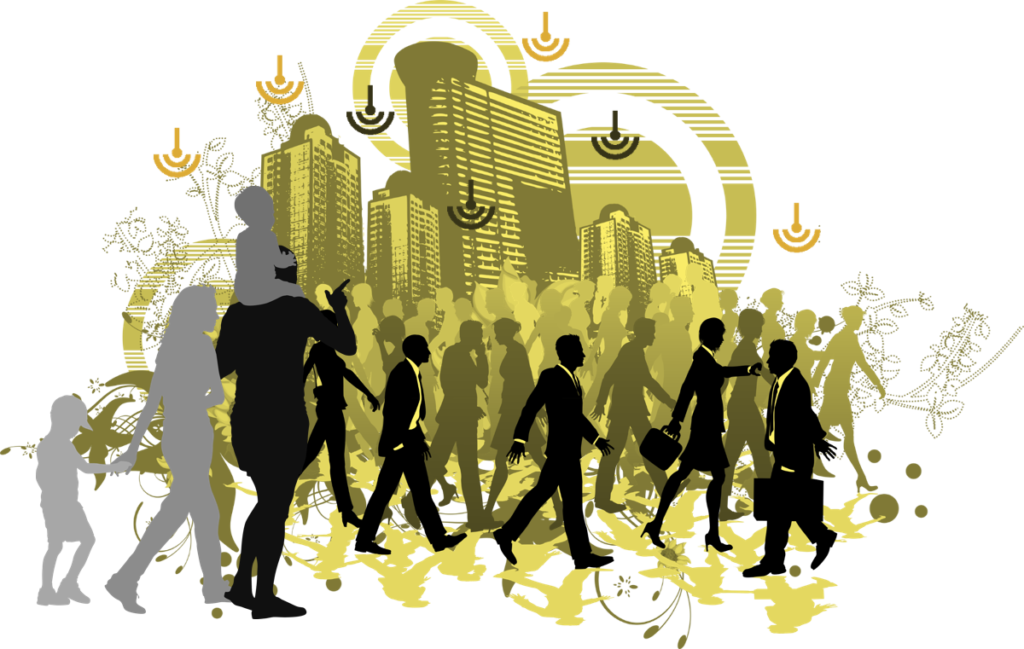Most discussions about smart cities focus on how technology can be leveraged to make urban systems more efficient. I believe no city deserves to be called “smart” unless it makes improving the quality of life for its residents the primary objective of its efforts. IBM believes “people” are one of the six core systems smart cities should optimize both individually and holistically. The other five “systems” are: business; transport; communication; water; and energy. I would add a seventh system — waste management (which would include both trash and sanitation). By making “people” one of the systems urban planners need to take into consideration, IBM hopes to ensure people are always part of the big picture.
Putting People First
Since technology is what puts the smarts in smart cities, it stands to reason that people with less access to technology risk being underserved — especially in developing countries. John Bachmann, an executive with AECOM, told Sophie Edwards, “Smart cities should be seen as a tool for greater equity, and planners need to ensure that people with less access to technology are not left behind. … Smart cities are of enormous relevance in developing countries where there is a huge infrastructure deficit and existing infrastructure systems aren’t even close to satisfying the needs of citizens.”[1] If their needs are taken into consideration, it follows that people with greater access to technology will also benefit. One of the most important things that can be accomplished is ensuring people get connected. Brookings’ analysts, Adie Tomer (@AdieTomer) and Rob Puentes (@rpuentes), bluntly state, “No industry or household in the world, will reach their future potential without access to broadband, it is the electricity of the 21st century.”[2] Bachmann asserts, “Smart cities should be promoted as people centric and as a tool for equilibrium and equity, not an end in itself.”
One undeniable global trend is urbanization — that is both good news and bad. Malia Politzer (@maliapolitzer) explains, “Organized efficiently, cities can be engines of economic growth. But poorly planned urbanization can have serious long-term consequences — leading to water shortages, skyrocketing rates of air pollution, gridlocked traffic and outbreaks of disease.”[3] She notes, “To address these diverse and complex problems, stakeholders are increasingly looking to build ‘smart cities,’ a city-planning concept that draws on new and existing technologies to make cities more efficient, inclusive and sustainable.” Inclusiveness may be the most difficult of those goals to achieve.
Philippe Orliange, director of strategy, partnerships, and communication at Agence Française de Développement, told Politzer, “Smart cities are about changing the fabric of urban policy so that citizens are involved in the design of the city, so that policies address real needs, and are socially inclusive.” Sunil Dubey, a senior advisor to Metropolis, the World Association of the Major Metropolises, agrees. He told Politzer, “Smart cities should be centered on the needs of local communities. Everything in a smart city — technology, policies, infrastructure — works towards the goal of improving the lives of the people living there.” At least it should.
Leveraging Technology to Benefit Citizens
“Technology has always been a critical force deeply intertwined with the evolution of cities,” writes Brooks Rainwater (@BrooksRainwater). “From the first human settlements millennia ago to the industrial revolution to today, technological breakthroughs have impacted the buildings we use, the way we get around and how we live, work and play in the urban space.”[4] He adds, “The development of smart cities builds upon this strong historical foundation with a digital foundation that allows cities to function more efficiently, be more responsive to community members and ultimately create better, more equitable urban environments where people thrive.” I like to think of cities as a living organism whose existence requires a brain (which I predict will be provided by cognitive computing), a central nervous system (which will be provided by the Internet of Things (IoT)), and functioning organs and appendages (i.e., systems, processes, and machines). People are the cells of that urban organism giving it shape and character.
Since technology is what puts the smarts into smart cities projects, it should come as no surprise the market for technologies is growing. Analysts from Arthur D. Little report, “The 100 largest cities in the world produce 25 per cent of the planet’s wealth. To succeed, more and more cities are going ‘smart’ in order to meet their biggest challenges and enrich the quality of their citizens’ lives. This unstoppable trend is driving double-digit growth in a trillion-dollar global market.”[5] They add, “Smart Cities are the new battleground for convergence across industries. Companies will need to step outside their comfort zones in order to leverage the billion-dollar opportunities that arise from the ambitions of cities to become smarter and more sustainable, with cross collaboration and creation of effective technology ecosystems being key for success. For those that are able to step up to the challenge, the rewards are likely to be significant.”
“Leveraging context-appropriate technology is fundamental to the success of any smart city,” asserts Politzer. “Such technology can take many forms: from online platforms and programs that facilitate interdepartmental communication, to designing smartphone applications that map public transportation routes, to lamp-posts equipped with weather and emissions sensors. The age of ‘big data’ has allowed city planners to collect citywide information on a scale previously unimaginable.” Bachmann adds, “We do need to focus on technology, it’s a fundamental part of smart cities, but it’s not the whole answer.”
Summary
Tom Cochran (@tommer), Chief Digital Strategist and Vice President for the public sector at Acquia, asks, “What if cities had compassion for their citizens and approached providing services with user empathy?”[6] Too often people view technology as cold and dispassionate. Cochran believes, however, that technology can and should be used and viewed as helpful and personal. He explains, “When cities put a priority on creating a great experience for every interaction, they become more compassionate and accessible in the process. What might happen if compassion were a core operating tenet of local governments? It would be an unorthodox approach to think of citizens as customers, tenaciously working to ensure they do not lose them to a competitor (i.e., moving to another city). But with this mindset, city leaders would be required to truly understand and empathize with their customers. A customer-focused city would deliver solutions that make lives better.” Rainwater agrees. “All of this prospective change,” he writes, “is predicated on the premise that technologies can help make people’s lives better in cities.”
Footnotes
[1] Sophie Edwards, “Smart cities need to make sure they don’t leave people behind,” Devex, 27 March 2017.
[2] Adie Tomer and Rob Puentes, “Here’s the Right Way to Build the Futuristic Cities of Our Dreams,” Wired, 23 April 2014.
[3] Malia Politzer, “Taking the smart route to inclusive, sustainable and connected cities,” Devex, 27 February 2017.
[4] Brooks Rainwater, “Smart cities must be people-centered, equitable cities,” TechCrunch, 24 February 2017.
[5] Ralf Baron, Morsi Berguiga, Jaap Kalkman, Adnan Merhaba, Ansgar Schlautmann, and Karim Taga, “Big Feature: Historic opportunities presented by smart cities,” Robotics & Automation News, 26 January 2017.
[6] Tom Cochran, “The Smartest Cities Are Compassionate Cities,” Citylab, 19 December 2016.





